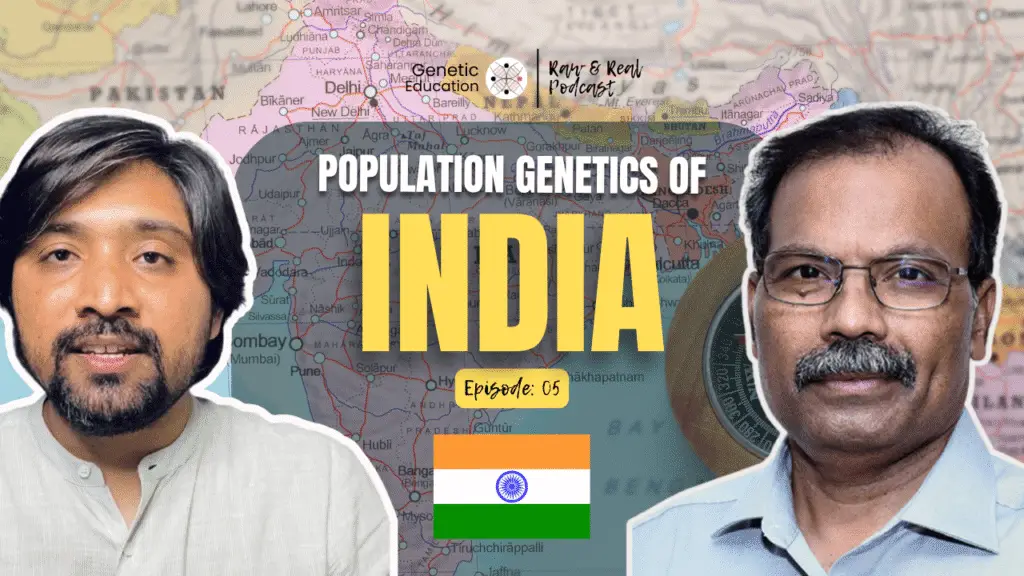In this episode of the Genetic Education podcast: Raw & Real, I (Dr. Tushar Chauhan) shot a video podcast with India’s leading scientist, Dr. Kumaraswamy Thangraj, Bhatnagar Fellow at CCMB, Hyderabad and former director of CDFD.
The podcast discussion mainly focused on his decades-long research on India’s ancestry and genetic structure, endogamy, and the vision behind the Genome India Project.
Related article: 5 Nationwide Projects Strengthening India’s Future in Genetics.
Key Topics:
About Dr. K. Thangaraj:
Dr. K. Thangaraj is one of India’s leading population geneticists. His work has helped trace how ancient migrations, isolated populations and social structures shaped India’s genetic landscape.
He has contributed to some of the most important studies on the genetic origins of Indians, the impact of endogamy and the biological basis of population-specific diseases.
For the last three decades, he has been working in the field of population genetics, human evolution, anthropology, genomics and many other interdisciplinary genetic fields.
Key Discussions From the Podcast:
Below is a clear summary of the major discussions from the episode.
India’s Ancestral Story Through DNA:
Dr. Thangaraj explained the migration pattern of ancient Indians and how the genetic diversity of India was shaped through this complex two-step migration event and the mixing of lineage groups across thousands of years
“Our genes carry the complete story of where we came from,” he said.
He also explained the population-specific genetic diversity and population-specific genetic diseases occurring in India and why they happen. And due to this complex genetic, social and population structure, it is difficult to study India’s genetics and ancestry.
How Endogamy Affected India’s Genetics:
We further discussed insights from Dr. K. Thangaraj’s latest research paper on endogamy and Indian genetics, which is one of the podcast’s strongest points and a major highlight.
He explained that, over generations, endogamy has increased the risk of certain recessive diseases and made them more common in specific populations. From their experience, he shared that ⅓ of the population is suffering from population-specific recessive diseases.
Understanding this allows scientists to identify disease variants faster and develop targeted solutions.
Genome India Project:
I am fascinated by the Genome India project. I read so many articles on this, but I want to know the backstory. During our discussion, Dr. K. Thangaraj gave a clear picture of the Genome India Project, one of India’s most important scientific missions.
The central objective of the GIP is to understand the genetic diversity of various Indian populations and to build the reference genetic map.
This data will help researchers:
• Identify population-specific diseases
• Improve early diagnosis
• Build better genetic tools for Indian patients
• Understand health risks linked to ancestry and endogamy
According to him, India needs its own genomic reference because Western datasets don’t represent Indian genetic diversity accurately.
Advice for Young Scientists:
Genetic Education’s vision is to spread scientific stories and inspire students, so we wrapped up the discussion by asking him to tell a few words to the young scientists. He told us that it is a great time for science in India.
The fund isn’t a problem now. Do good work, and the government will definitely fund you. It is a golden time for India in science, he further added.
Key Takeaways:
- India’s population structure is shaped by ancient migrations, isolation and endogamy.
- Endogamy has contributed to population-specific diseases across different communities.
- The Genome India Project is building a national genomic reference map.
- Western genetic datasets do not represent India’s diversity.
- India needs more population-specific studies to improve diagnosis and treatment.
- Genetics can help trace ancestry as well as guide personalised healthcare.
Related article: [Insights] Latest Podcast With Dr. Ashwin Dalal On Rare Genetic Diseases in India.
Why It Matters:
India has one of the most complex genetic landscapes on the planet. The work of Dr. K. Thangaraj and many other scientists helps us understand our ancestry as well as disease patterns, diagnosis, newborn screening, carrier status and public health.
Scientists like Dr. K. Thangaraj has been building India’s genomic foundation for years. For students and researchers, this episode offers a clear look at the importance of population genetic studies, and how they can contribute to medicine and society.
Editor’s Note:
Speaking with Dr. K. Thangaraj was genuinely inspiring. What stood out to me was his clarity both in science and in purpose.
He reminded me why understanding India’s population genetics is essential if we want to build a healthier country.
This conversation reinforced why we started Genetic Education: to highlight Indian scientists and tell the stories that often stay inside labs.
— Dr. Tushar Chauhan
Watch the full podcast: Dr. K. Thangaraj Explained The Genetics of India.

![[Insights] Latest Podcast With Dr. Ashwin Dalal On Rare Genetic Diseases in India](https://geneticeducation.co.in/wp-content/uploads/2025/10/Dr-Ashwin-sir-min-1024x576.png)
